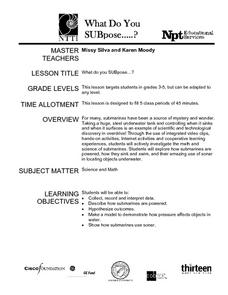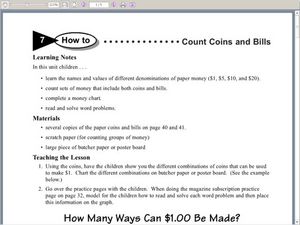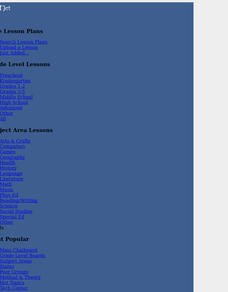Curated OER
Sports Math
Fifth graders participate in a variety of sports related problem solving equations that involve fractions, decimals and percents. They explain the relationships and equivalences among integers, fractions, decimals and percents with a...
Curated OER
Problem Posing Mathematics
Students work on multiplication problems. In this hands-on math activity, students practice the concept of multiplication through manipulatives, arrays, pictures, and drawings. They discover other ways of learning multiplication besides...
Curated OER
Atlatl Lessons for Grade 4
Fourth graders explore the weapons of the Aboriginal people. In this fourth grade math lesson, 4th graders create charts, tables, or diagrams to represent patterns and relations. Students investigate which dart length has the best...
Curated OER
Fairy Tales Come True
Pupils see how to solve math problems using place value. After watching an episode from Cyberchase, kids work together using hands-on materials to solve the problems given. This outstanding, ten-page lesson plan has everything you need...
Curated OER
Bye, Bye, Bye, Fraction Phobia!
Young mathematicians utilize video, the internet, and hands-on learning experiences in order to recognize that fractions aren't as "scary" as they first appear, and that we use them every day in our lives. The hands-on activities in this...
Curated OER
Discovering Pi/Welcome to Pi Day
Students explore pi. In this circle measurement lesson, students define and identify radius, diameter, circumference, and perimeter. Students work in groups to measure several plastic lids and record their findings. Students compare the...
Curated OER
What Do You SUBpose?
Submarines are the fous of this math and science instructional activity. In it, learners explore the world of submarines: how they work, and what they are used for. They engage in hands-on activities, watch video clips, and work in...
Curated OER
Alexander Used to Be Rich
Reading Alexander, Who Used to Be Rich Last Sunday, launches this lesson appropriate for children who recognize coins and have been introduced to coin values. Using addition and subtraction skills, the class tracks Alexander’s spending...
Curated OER
"Just Cruising"
Practice writing the same number sentence in a variety of ways. Learners will explore math cruise ship problems to write equivalent sentences. Then complete word problems which have been included in multiple languages.
Curated OER
Colonial Vacation Planner
Looking for a good lesson on the Colonial Period for your upper-elementary class? Then, this lesson is for you! They use website designs, U.S. travel publications, and maps to plan a family vacation to states which were part of the...
Curated OER
Lady Liberty
If you're looking for a fantastic cross-curricular lesson on the Statue of Liberty, then this lesson is for you! Learners watch a Reading Rainbow episode which focuses on the Statue, then gather facts about the creation, construction,...
Curated OER
Is That Measurement Stuff For Real, Life?
Fifth and sixth graders engage in a series of activities which show them the importance of using different types of measurement strategies. One of the primary goals of the lesson is to show learners that measurement is helpful in many...
Curated OER
Barter vs. Money
First graders listen to the book, Sheep in a Shop, that leads them to think about making financial decisions, trading, and the barter system. After the book is read aloud, a discussion ensues about some of the things that the sheep...
Curated OER
Count Coins and Bills
Lower graders recognize coins and paper money and understand its value. They participate in a variety of money problems to appreciate the value of money. Students add, subtract, chart and solve money problems.
Institute of Electrical and Electronics Engineers
Sugar Crystal Challenge
Blow your learners' minds with a sweet lesson on nanotechnology that uses sugar to demonstrate the difference nanoscale surface area makes in dissolving and crystal formation. Plenty of supportive background information is read to...
Curated OER
Fish and Clips
Youngsters test magnetic strength by measuring the mass of paper clips that they "hook" with a magnet. Your first and second graders should love the hands-on activities associated with this plan. The reproducible materials are quite good...
Curated OER
Marriage and Financial Goals, Budgeting Strategies
There is no more useful life skill to learn than budgeting and setting financial goals. It's math that is used by every person, everyday. Learners examine the responsibilities and costs involved in family economics. Through a series of...
Curated OER
T-Shirt Lettering
Learners determine the cost of a t-shirt using a variety of mathematical operations to solve problems. Then they use a spreadsheet to calculate the cost of lettering a t-shirt and display this information in a graph.
Curated OER
Measuring the Earth (Eratoshenes' method)
Sixth graders engage in problem solving, communicating, reasoning, and connecting to represent and solve problems, using geometric models.
Curated OER
What Do We Do With A Dirty Bomb?
Students examine composition of dirty bomb and its possible effects on a city, and investigate simulations of such an event; students use computational and problem solving skills to assess damage and prepare report proposing solution to...
Curated OER
ZIP Code Math
Students add or subtract to solve ZIP Code Math word problems. A ZIP Code Math work sheet is included. This lesson combines math with geography quite nicely.
Alabama Learning Exchange
Tiger Math Graphing
Learners practice various skills using the book Tiger Math: Learning to Graph from a Baby Tiger. After listening to the story, they create a pictograph using data collected from the text. They also color a picture of a tiger, collect...
Curated OER
An Introduction To Solving And Graphing Inequalities
Young scholars graph inequalities and solve the equations. In this algebra lesson, students graph their solutions on a number line and create an inequality for a word problem.
Curated OER
Finding Satisfactory Solutions
Students decide where to locate ice cream stands in a town so that no one has to travel too far to buy a treat. The problem-solving strategies for this problem give students a chance to decide what makes a solution satisfactory.

























